The brief handwritten note arrived several years ago in the mail addressed to Notre Dame Magazine.
“Please Sir: Can you add my mother’s name on your alumni list (for) year 1928? First women who graduated from ND.” It is signed by a resident of Coral Gables, Florida.
Enclosed was a black-and-white snapshot of two young women in commencement caps and gowns standing near the Grotto. An arrow points to the woman on the right, the writer’s mother.
“Mary Preger Axnix graduation, 1928. ND Grotto,” was written on the back.
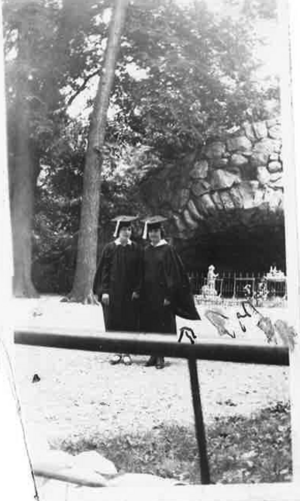
Although Notre Dame’s undergraduate program became fully coeducational in 1972, women have been attending the University and earning degrees since World War I. It’s estimated that more than 4,500 women earned Notre Dame degrees before 1972.
The first two women completed master’s degrees in 1917. The number of female students grew the following year, when Notre Dame formally launched a summer school program. Enrollment that summer exceeded 200 students, many of them religious sisters, according to the exhibit “Daughters of Our Lady: Finding a Place at Notre Dame,” on display in the Rare Books & Special Collections Room of the Hesburgh Library until December 16.
Who were some of those early women graduates? And what were their lives like?
Today they are recalled mostly as names in faded commencement programs. Most of the first female graduates were religious sisters, but laywomen also attended and earned degrees in those years. Many of the early laywomen graduates — including Mary Preger Axnix – were South Bend public school teachers.
Although they were students, their photos didn’t appear in the Dome yearbooks. Most of the early female graduates never received mention in the Notre Dame Alumnus magazine. Some of them are not listed in the Notre Dame Alumni Association online directory. (The database includes graduates both living and dead.)
Alumnae from 1917 to 1963, including their degrees, are listed in a chart created by the Notre Dame Archives. (The spreadsheet, intended to list all female graduates up to 1972, is a work in progress.)
Many of the early women students — both religious sisters and laywomen — already were teachers when they enrolled at Notre Dame and went on to decades-long careers as professional educators. They inspired colleagues, taught generations of youths and contributed to their communities, yet their life stories and accomplishments remain largely unchronicled.
Obituaries, vintage newspaper articles, ancestry records and other sources help fill in some of the blanks. Here is a glimpse at the lives and achievements of just a few of those women:
LAYWOMEN
Of the 24 laywomen who had earned Notre Dame degrees by 1930, 14 of them were South Bend public school teachers.
It’s not clear if there was a formal arrangement between the South Bend public schools and Notre Dame to enroll teachers in the University’s summer school — or if the teachers enrolled and paid for the college courses on their own.
As late as the 1930s, Indiana didn’t require a college degree in order for an individual to teach school. Additional education obtained by teachers during their summer vacations was taken into consideration by their school board toward evaluating a teacher’s skill and determining salary increases.
Antoinette J. Semortier 1922, ’31M.A.
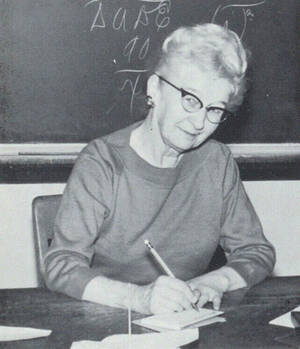
In August 1922, South Bend native Antoinette J. Semortier became the first laywoman to earn a Notre Dame bachelor’s degree. Nine years later, she completed a master’s degree. She was active in and served as secretary of the Women’s Club of the Notre Dame Alumni Association, formed in 1927 for the University’s alumnae. (The Women’s Club published at least three directories of its members, in 1928, 1933 and 1935. The organization seems to have faded away by 1940.)
Born in 1895, Semortier was the daughter of immigrant parents from France and Belgium. Orphaned by her late teens, she graduated from South Bend High School in 1914 and started teaching in the public schools. Semortier took some summer classes at Indiana University before enrolling at Notre Dame.
Semortier worked as a teacher for 62 years. She taught mathematics at South Bend Central High School from 1928 to 1965. Her work included helping students prepare for the annual state mathematics contest. In 1937-38, she taught at Montrose Academy in Angus, Scotland, through a teacher exchange program arranged by the American Association of University Women. She was a member and local chapter president of Delta Kappa Gamma, a professional society for women educators, and taught part-time at Saint Mary's College. From 1965 until her retirement in 1977, she taught in Williamsville, N.Y.
Semortier died at age 95 in 1991 in St. Charles, Missouri, and is buried in Cedar Grove Cemetery.
Her younger sister, Constance, became a Holy Cross sister. Sister Mary Augustella Semortier earned a bachelor’s degree from Notre Dame in 1927 and later was head librarian at Saint Mary’s College.
Nina Stuck Doolittle 1923
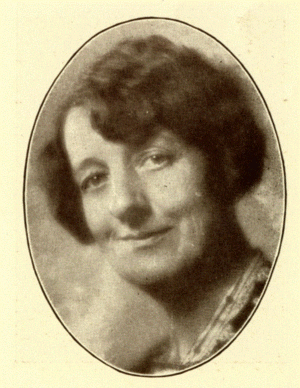
Born in 1879 in Allegan, Michigan, Nina Stuck Doolittle graduated from South Bend High School in 1897. She was teaching in the South Bend public schools two years later. She attended summer classes at New York University and the University of Chicago before enrolling at Notre Dame. She earned her Notre Dame bachelor’s degree at age 43.
In 1915, Doolittle became the first teacher in the South Bend schools to focus on teaching developmentally disabled and other special-needs students. It was called the “Opportunity Room” at Laurel School, and Doolittle by 1921 was its director. (Notre Dame classmate Sarah M. O’Neill 1923, ’27M.A. also taught in the program.) Doolittle continued in this teaching specialty for the rest of her career. She also taught night school classes for recently arrived immigrants, served as president of the local teachers’ union and was active in local women’s clubs.
Doolittle was married for a time, but records indicate she divorced and raised her two sons on her own. In 1931, at age 51, Doolittle took her own life. Relatives attributed her action to illness and anxiety. She was buried in her hometown of Allegan.
Cecilia Bain Buechner ’28 and ’31M.A.
Born in 1879 in North Liberty, Indiana, Cecilia Bain was teaching in the South Bend schools by 1908. She married George Buechner in 1912. The couple had no children. She taught history and social studies at South Bend Central Junior High School and Jefferson School until at least 1935.
She earned her Notre Dame bachelor’s degree at age 49, and continued taking Notre Dame summer classes after completing her master’s degree at age 52.
Buechner was the author of a 62-page booklet, “The Pokagons,” published in 1933 by the Indiana Historical Society, which tells the history of the Pokagon Band of Potawatomi in Indiana and Michigan. The Pokagons were the subject of her master’s degree dissertation. In the introduction, she credited Notre Dame as a source for her research and Rev. James A. Burns, Notre Dame’s president from 1919 to 1922, for reading the manuscript and offering her valuable suggestions.
In retirement, she moved to Laguna Beach, California. She died there in 1977 at age 98.
Crissie E. Reimold ’28
Born in 1890 in Saginaw, Michigan, Crissie Reimold started her career teaching in a one-room schoolhouse in Utah. She was teaching in the South Bend schools by 1920. After receiving her Notre Dame bachelor’s degree, she went on to earn a master’s degree at Columbia University. In 1932, Reimold was named principal of Studebaker School in South Bend, a position she held until retirement 26 years later. She later moved to Florida.
Although blind in her later years, Reimold continued to travel and enjoy life. “I think the world is a lot better off if women have an important place, a place to express their opinions,” she said in a South Bend Tribune interview in 1981 during a visit back to the city. She died at age 99 in 1989 in Clearwater, Florida.
“Miss Reimold expected teachers and students alike to work up to their potential and to take pride in their school. She refused to tolerate any deviation from these high standards,” a former colleague wrote in a tribute shortly after Reimold’s death.
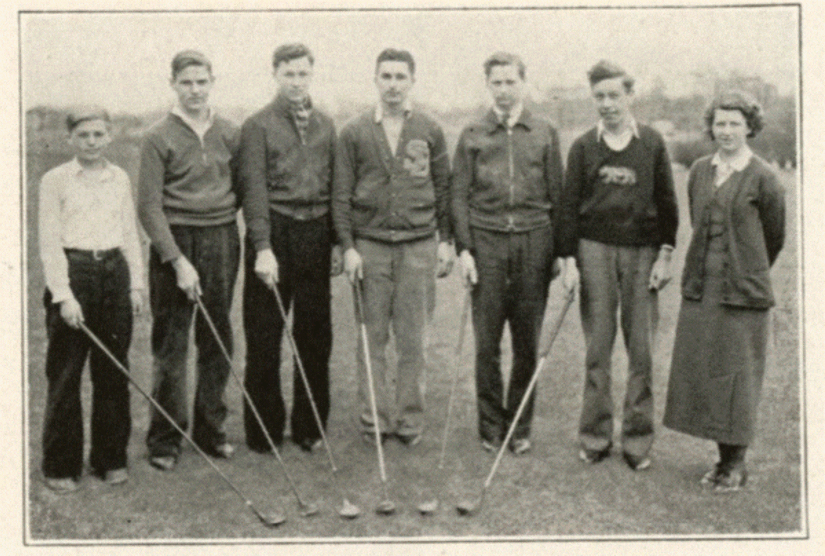
Margaret J. Kinerk ’28
Born in 1902 in South Bend, Margaret Kinerk graduated from South Bend High School in 1919 and earned a teaching certificate at Saint Mary’s College in 1921. She was teaching at Perley School near Notre Dame by 1922. She went on to serve as a longtime social studies teacher at Riley High School.
From 1932 to 1939, she also coached the Riley boys’ golf team. Her teams in 1934 and 1938 won the Northern Indiana High School Conference championship and in 1937-38 tied for the state title. She was a gifted golfer herself, and Kinerk’s victories in tournaments drew headlines in area newspapers from the 1920s well into her senior years.
In 1963, Kinerk took a sabbatical from teaching and went on a seven-month around the world trip, visiting Europe, the Middle East, India, Nepal, Thailand, Singapore, Hong Kong, the Philippines, Japan and Hawaii, providing community lectures about her travels after she returned. She retired in the late 1960s after nearly 50 years as an educator. She died at age 83 in 1986.
RELIGIOUS SISTERS
Sister Mary Lucretia Kearns, CSC, 1917M.S., 1923Ph.D.
Born Helen Mary Kearns in 1868 in Galway, Ireland, she immigrated as a teen with her family to the United States. They settled in Chicago. She entered the Sisters of Holy Cross in 1903, taking her final vows in 1908.
Kearns earned a Notre Dame’s master’s degree in chemistry, then a doctorate in organic chemistry. She served for many years on the faculty at Saint Mary’s College, including for 10 years as head of the science department. She was elected head of the congregation’s Midwest Province in 1936 and superior of the congregation’s Provincial House in 1939. She died in 1954.
Sister Mary Francis Jerome O’Laughlin, CSC, ’17M.A.
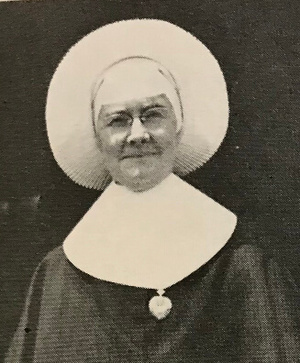
Born Susan A. O’Laughlin in 1877 in Seneca, Illinois, she entered the Sisters of Holy Cross in 1896. She earned a bachelor’s degree at Saint Mary’s and taught at the college for about 50 years. After completing her Notre Dame degree, she earned a Ph.D. at Fordham University. She was head of Saint Mary’s classical languages department from 1922 to 1945, vice president of the college from 1931 to 1947, and religious superior at Saint Mary’s for several years before her death at age 72 in 1948.
In her will, she left a $500,000 family inheritance to the college building fund for the Moreau fine arts complex that was being planned at the time of her death. O’Laughlin Auditorium is named in her honor.
Sister Mary Madeleva Wolff 1918M.A.
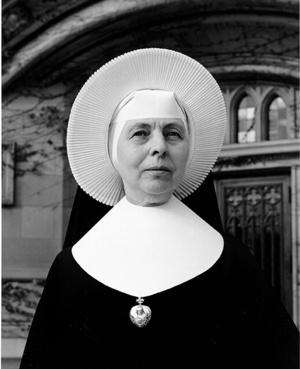
Born Mary Evaline Wolff in 1887 in Cumberland, Wisconsin, she entered the Sisters of Holy Cross in 1908 and received her Saint Mary’s bachelor’s degree in 1909. A few years later, she started taking classes at Notre Dame.
“Four of us young sisters had been assigned to study for our Master’s degree at the University of Notre Dame. These we received in June, 1918. The experience, for all the pressures of ways and means, amounted to mental luxury,” Wolff wrote 40 years later in her autobiography.
Wolff went on to earn a doctoral degree from the University of California, Berkeley in 1925. She started publishing poetry and essays in 1923, came to be known as the “lady abbess of nun poets” and eventually wrote more than 20 books.
She taught on the English faculty at Saint Mary’s and served as the college president from 1934 to 1961. She founded the Graduate School of Sacred Theology in 1943, making Saint Mary’s the first Catholic women’s college to admit both religious and lay people to earn advanced theology degrees. (At the time, Catholic universities wouldn’t permit women to study for advanced degrees in theology.)
Wolff died in 1964 at age 77. Madeleva Hall at Saint Mary’s is named in her honor.
Sister Mary Eleanore Brosnahan 1918M.A., 1923Ph.D.
Born Katherine Brosnahan in 1890 in Pierceton, Indiana, she earned a bachelor’s degree from Saint Mary’s in 1914. From 1918 to 1934, she taught English at the college. After earning two Notre Dame degrees, she pursued additional graduate work in Cambridge, Massachusetts and at the University of Illinois.
In 1927, she was elected the first president of the Women’s Club of the Notre Dame Alumni Association. In 1937, as Mother M. Eleanore, she was named general councilor of Saint Mary’s convent. She died at age 50 in 1940.
Sister Mary Aloysi Kiener, SND, 1922, 1923, ’30Ph.D
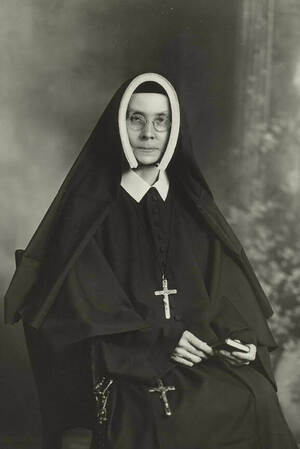
Kiener, of Cleveland, Ohio, was a member of the Sisters of Notre Dame religious order. In 1922, Kiener — at age 41 — was in the first group of five women who earned Notre Dame bachelor’s degrees, and she went on to become the first female triple Domer.
Born Mary Agnes Kiener in 1881 in Cleveland to German immigrant parents, she entered the convent at age 16 and was a teacher by 1898. She taught at various Catholic schools in Cleveland and Covington, Kentucky, for more than 20 years, then had the opportunity to attend Notre Dame. While studying on campus, she and several other sisters from her order handled the domestic work at Holy Cross Seminary. She was named the superior of that sisterhood.
“Our Lady’s school made large demands on time and effort, and the sequel shows that scholarship has its own compensations,” Kiener later wrote. Her doctoral dissertation was on English theologian and intellectual John Henry Cardinal Newman.
Kiener spent 24 years teaching English and religion at Notre Dame College in South Euclid, Ohio, wrote several religious books and translated others from German to English. From 1947 to 1959, she served in Rome as assistant general of her order. She returned to Notre Dame College and continued teaching until retirement in 1964.
“In glancing backward, one naturally pauses to give thanks. A home where the sanctities of family life and culture were held in high esteem; my own religious Congregation, cherishing high ideals of Marian virtue and learning; the University of Notre Dame and the Lady of the Golden Dome,” Kiener wrote late in life. She died in 1975 at age 93 in Chardon, Ohio.
RECLAIMING WOMEN’S HISTORY
Little historical research has been done on Notre Dame’s early women graduates.
These brief biographical sketches just skim the surface of the lives of a few of the women. The details are drawn mostly from second-hand sources, because professional women and religious sisters weren’t often interviewed in the early 20th century.
I shared a bit about my own research with a recent graduate. She said those early alumnae deserve recognition and their place in Notre Dame history.
The University plans to commemorate the 50th anniversary of the admission of undergraduate women by redesigning the Main Circle to honor Notre Dame women.
It would make an excellent and lasting testament to the early alumnae to create a complete list of all pre-1972 female Notre Dame graduates, confirm their degrees and make sure they are included in the alumni database.
Tracking down the life stories of more early female graduates would be a way of recording their achievements and assuring they are not forgotten.
EPILOGUE
And what of Mary P. Axnix ’28, the young woman in the snapshot at the Grotto?
The daughter of Hungarian immigrants, Mary Preger was born in South Bend in 1903 and graduated from South Bend High School in 1921. By 1925, she was working as a third-grade teacher at Oliver School and had started taking summer classes at Notre Dame.
In 1927, she married Eugene J. Axnix. The following year, at age 24, she completed her Notre Dame bachelor’s degree. The couple had two children: Celia and Eugene Jr.
Mary Axnix apparently was a full-time homemaker for a few years, but by 1933 returned to teaching.

From 1939 to 1969, she taught at Linden School on South Bend’s west side. By the 1950s, in the era before desegregation, Linden served a primarily African-American student body and the aging school received far fewer resources than other city schools that served mostly white students.
Axnix was dedicated, often working extra hours with individual students. Axnix — who was fluent in Hungarian — also taught English to Hungarian refugees who settled in South Bend following the Hungarian Revolution of 1956.
In 1959, Axnix was named the city’s Teacher of the Year, and later that year was honored as state Teacher of the Year by the Indiana Federation of Women’s Clubs. “I feel I have been put in a particular spot where I can do good,” Axnix told a reporter at the time.
She chose to work where she felt most needed. “I know what it is to combat prejudices,” she said. “When I was young, many people looked down on Hungarians as foreigners. They felt a Hungarian child should not go to school beyond the fifth grade.”
In 1968, Mary Preger Axnix’s husband died and she retired after more than 40 years of teaching. She died at age 80 in 1983 in Coral Gables, Florida, and was buried in Hungarian Sacred Heart Cemetery in South Bend. Survivors included her daughter and son, 10 grandchildren and two great-grandchildren.
The last line of her obituary read: “She graduated from the University of Notre Dame in the summer of 1928.”
Margaret Fosmoe is an associate editor of this magazine. Contact her at mfosmoe@nd.edu or @mfosmoe.